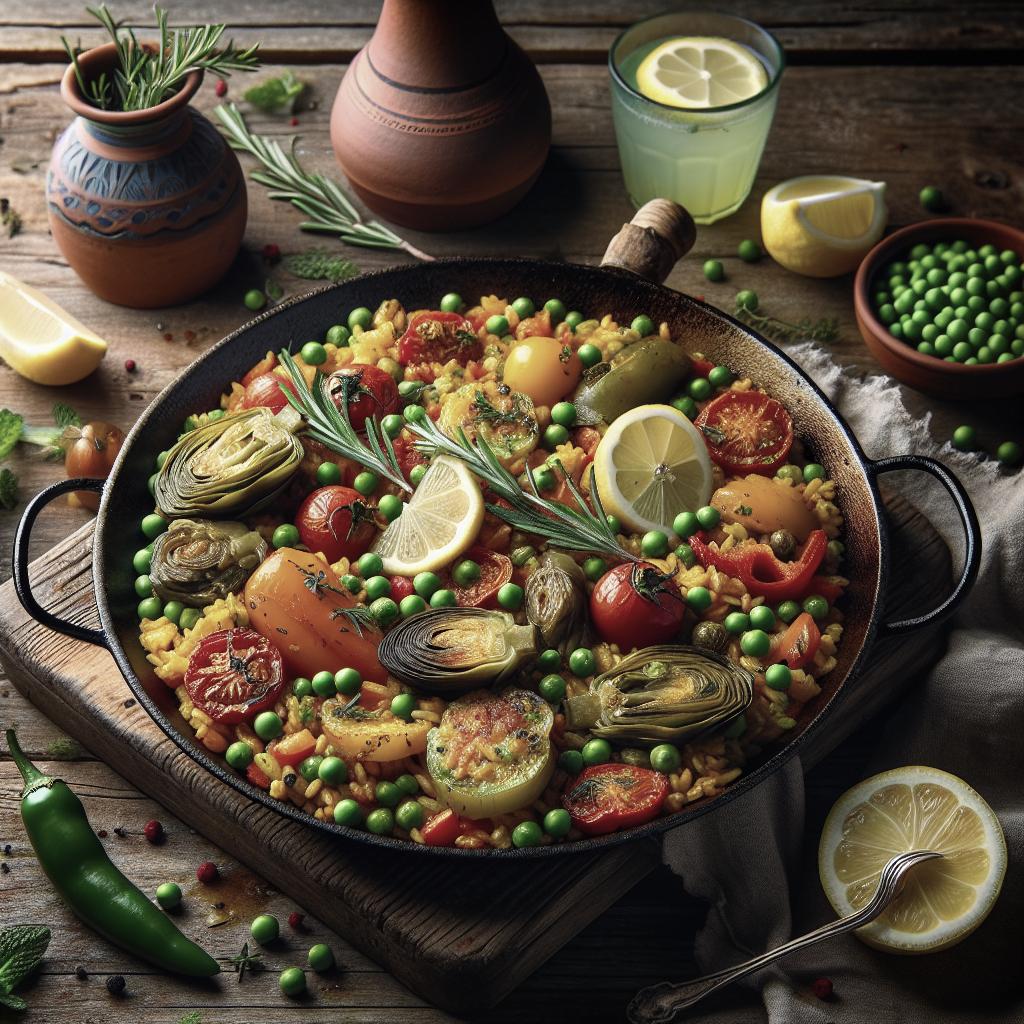Vegan Paella: A Delicious Destination Near You
Vegan paella offers a delightful twist on a classic Spanish dish, bringing plant-based goodness to the table without compromising on flavor. In this comprehensive guide, we’ll explore how to make vegan paella right at home, delve into the intricacies of Spanish vegan paella, and provide a detailed recipe for you to try. We’ll also address common questions about the dish, such as the type of rice to use, the secret to its golden hue, and whether you need a specific pan to cook it. Additionally, we’ll introduce the concept of socarrat—an integral component of authentic paella. For those who love vibrant and tasty meals, we’ve included additional vegan dinner recipe suggestions and a nutritional breakdown. Join us on this culinary journey and discover how vegan paella can become a delicious destination in your kitchen.
HOW TO MAKE VEGAN PAELLA
Making vegan paella can be a rewarding culinary experience that brings the vibrant flavors of Spain into your home. Start by selecting fresh vegetables such as bell peppers, artichokes, and peas to add rich color and nutrition. A good vegetable broth will form the base of your paella, providing depth and umami flavor. Consider adding chickpeas or your favorite plant-based protein for a satisfying meal.
The key to a great vegan paella is in the seasoning. Use spices like smoked paprika and saffron to mimic the authentic taste of traditional paella. These spices not only contribute to the dish’s signature aroma but also enhance its earthy and aromatic profile. Cooking slowly and letting the flavors meld together is crucial, so have patience and enjoy the process of bringing each ingredient to life.
SPANISH VEGAN PAELLA
Spanish vegan paella embraces the heart and soul of a nation’s beloved dish while adhering to plant-based principles. Traditional paella hails from Valencia, Spain and typically features seafood or meat. In the vegan rendition, the essence of Spanish cuisine is maintained through the careful selection of ingredients that mirror the flavors and textures found in the classic version.
Using a variety of locally-sourced Mediterranean vegetables, Spanish vegan paella often includes elements like tomatoes, garlic, and green beans. Aside from bringing a burst of color, these ingredients ensure that the dish remains true to its Spanish roots. To elevate the experience, garnish your paella with fresh herbs such as parsley and a squeeze of lemon juice to brighten the flavors.
RECIPE
INGREDIENTS
- 2 tablespoons olive oil
- 1 onion, finely chopped
- 3 cloves garlic, minced
- 1 red bell pepper, sliced
- 1 yellow bell pepper, sliced
- 1 cup artichoke hearts
- 1 cup fresh or frozen peas
- 1 can chickpeas, drained and rinsed
- 2 cups short-grain rice (such as Bomba or Arborio)
- 4 cups vegetable broth
- Pinch of saffron threads
- 1 teaspoon smoked paprika
- Salt and pepper to taste
- Fresh parsley for garnish
- Lemon wedges for serving
INSTRUCTIONS
- Heat olive oil in a large paella pan or skillet over medium heat. Add the onion and garlic, sautéing until fragrant.
- Add the bell peppers, artichoke hearts, peas, and chickpeas, and cook for another 5 minutes.
- Stir in the rice, ensuring it is well coated with the oil and vegetables.
- Incorporate the vegetable broth, saffron, smoked paprika, salt, and pepper. Bring to a gentle boil.
- Reduce the heat and let simmer without stirring until the rice is tender and liquid is absorbed, about 20-25 minutes.
- Turn up the heat for the last few minutes to form a crust at the bottom of the pan, known as socarrat.
- Remove from heat and let sit for 5 minutes. Garnish with fresh parsley and serve with lemon wedges.
NOTES
For best results, use high-quality saffron for an authentic flavor. If saffron is unavailable, turmeric can be used as a substitute for color. Feel free to customize the recipe by adding other seasonal vegetables or plant-based proteins of your choice.
WHAT KIND OF RICE DO I NEED FOR VEGAN PAELLA?
The choice of rice is pivotal in crafting an authentic vegan paella. Traditionally, varieties such as Bomba or Calasparra are preferred due to their excellent water absorption capacities. These short-grain rice types remain firm yet tender, beautifully absorbing the rich flavors of the broth without becoming mushy.
While Bomba and Calasparra rice are ideal, Arborio rice can also be a suitable alternative, offering a slightly creamier consistency. The key is to choose a rice variant that can hold its shape and absorb liquid efficiently, resulting in a perfectly cooked, cohesive dish.
WHAT GIVES PAELLA ITS GOLDEN COLOR?
The iconic golden hue of paella can be attributed primarily to saffron, a prized spice that not only colors the dish but also imparts a subtle, floral aroma. Saffron threads should be gently toasted and steeped in the broth to release their full potential within the dish.
For those seeking a more economically-friendly option, turmeric offers an alternative. While turmeric provides a similar visual appeal, it’s important to adjust the quantity to avoid overwhelming the traditional flavor profile of the paella.
DO I NEED A PAELLA PAN TO MAKE THIS VEGAN PAELLA?
While a traditional paella pan, known as a ‘paellera’, is designed for even cooking and forming that coveted socarrat, it’s not strictly necessary for crafting a delectable vegan paella at home. A large, shallow skillet with a wide surface area can effectively serve the same purpose.
The primary objective is to achieve even heat distribution, allowing the rice to cook uniformly and develop a crispy bottom layer. If using a substitute pan, ensure that it is non-stick or well-seasoned to facilitate easy serving and cleanup.
WHAT IS SOCARRAT?
Socarrat refers to the crispy, caramelized layer of rice at the bottom of a paella pan, a hallmark of traditional paella. This layer is achieved by turning up the heat towards the end of cooking, allowing the rice to toast against the pan without burning.
Considered a delicacy among paella purists, socarrat offers a rich texture contrast and an intensified concentration of flavors. Achieving the perfect socarrat requires a watchful eye and precise heat control, ensuring that the rice is toasted to perfection but not charred beyond enjoyment.
MORE VEGAN DINNER RECIPES
LOVE FOOD WITH LOTS OF FLAVOR? YOU MAY BE INTERESTED IN THESE MOUTH-WATERING RECIPES:
- Smoky Portobello Mushroom Tacos
- Creamy Coconut Curry with Tofu
- Lentil Shepherd’s Pie with Sweet Potato Topping
- Grilled Vegetable and Quinoa Salad
- Ethiopian Spiced Chickpea Stew
NUTRITION
A typical serving of vegan paella is not only delicious but also packed with nutrients. It’s a great source of plant-based protein, vitamins A and C from the vegetables, as well as iron and fiber from chickpeas and rice. The use of olive oil adds healthy fats, contributing to heart health.
Final thoughts
Vegan paella offers a vibrant and flavorful introduction to Spanish cuisine without the use of animal products. Its customizable nature allows cooks to tailor the recipe to their preferences, making it an inclusive dish for all palates. Whether you’re a seasoned chef or a novice in the kitchen, creating vegan paella at home can be an exciting culinary adventure, bringing the rich culture and flavors of Spain to your dining table.
| Aspect | Details |
|---|---|
| Core Ingredients | Mixed vegetables, chickpeas, saffron rice |
| Cooking Technique | Slow simmer, followed by high heat for socarrat |
| Special Equipment | Paella pan optional |
| Flavor Profile | Rich and aromatic with smoked paprika and saffron |
| Dietary Consideration | Vegan, plant-based |


